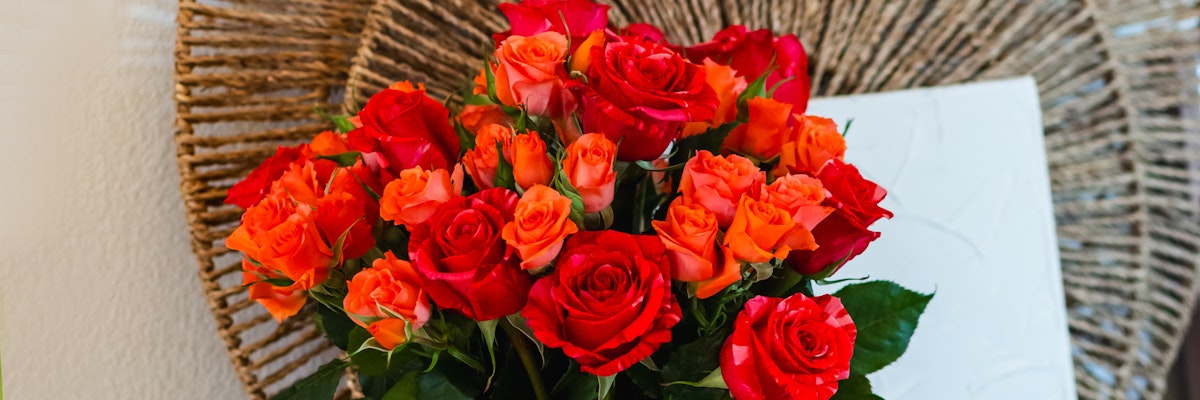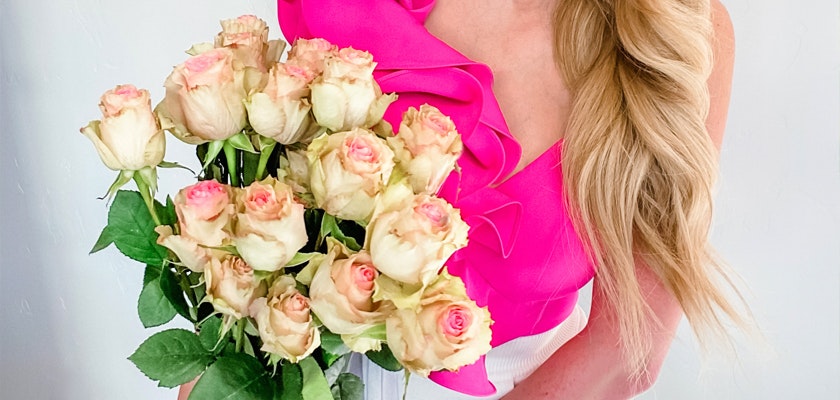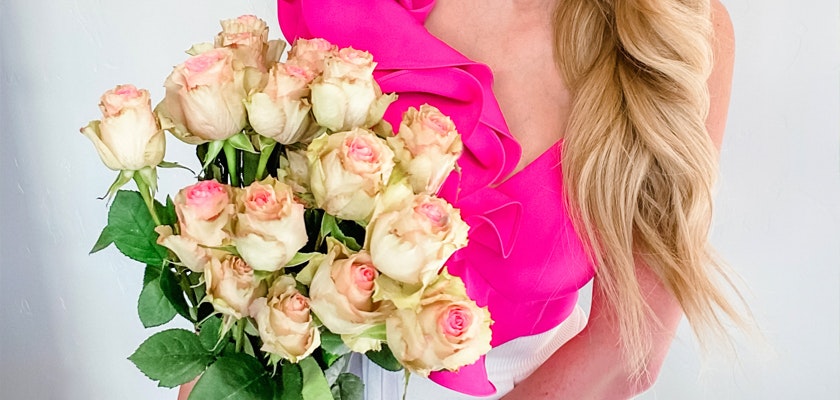Discovering the Language of Roses: A Global Journey
The rose, with its delicate petals and enchanting fragrance, transcends cultures, embodying emotions from love to remembrance. Its universal appeal makes it a symbol recognized around the globe, yet the way we refer to this exquisite bloom varies intriguingly from language to language.
Discover the word "rose" in 50 languages, celebrating its global charm and cultural diversity with BloomsyBox
This blog embarks on a fascinating journey to explore how the word "rose" is pronounced across different tongues, offering a glimpse into the rich tapestry of global languages. Through this exploration, we not only celebrate the beauty of the rose but also the diversity of human culture.
Roses are more than just flowers; they are a universal language of emotion, capable of conveying messages that words alone cannot. Whether it's love, apology, celebration, or sorrow, roses have the power to express the deepest feelings in the most elegant manner. Understanding the name of this flower in various languages enhances our appreciation for its global significance and the shared human experiences it represents.
Discover the word "rose" in 50 languages, celebrating its global charm and cultural diversity with BloomsyBox
This blog embarks on a fascinating journey to explore how the word "rose" is pronounced across different tongues, offering a glimpse into the rich tapestry of global languages. Through this exploration, we not only celebrate the beauty of the rose but also the diversity of human culture.
Roses are more than just flowers; they are a universal language of emotion, capable of conveying messages that words alone cannot. Whether it's love, apology, celebration, or sorrow, roses have the power to express the deepest feelings in the most elegant manner. Understanding the name of this flower in various languages enhances our appreciation for its global significance and the shared human experiences it represents.
Our exploration is not just an academic exercise; it's a journey that connects us to different cultures and traditions. By learning to say "rose" in multiple languages, we embrace a form of global citizenship, acknowledging the commonalities that unite us across borders. This knowledge enriches our interactions, whether we're travelers seeking to connect with locals, lovers aiming to impress with a multilingual bouquet card, or simply curious minds eager to expand our linguistic horizons.
Moreover, the rose's linguistic journey invites us to reflect on the nature of language itself—how it shapes our perception of the world and fosters connections between seemingly disparate communities. As we delve into the names of the rose, we uncover stories of migration, trade, and cultural exchange, illustrating how interconnected our world truly is.
Join us as we traverse continents and languages, discovering how to express one of the most profound symbols of love and beauty. From the familiar to the exotic, each name for the rose adds a layer to our understanding of this beloved flower, enriching our appreciation for both nature and the diverse tapestry of human culture.
The Rose in Fifty World Languages
Embarking on a global tour, we unveil how the word "rose" is woven into the linguistic fabric of various cultures. From the rolling hills of Europe to the vibrant landscapes of Asia, from the rich heritage of Africa to the diverse ecosystems of the Americas, the rose holds a special place in many languages and hearts.
Europe's Blossoming Terms
In the continent where roses have been cultivated for centuries, each language offers a unique name for this cherished flower. For instance, in France, the rose is known as "rose," a term that has also permeated English and several other languages, highlighting the flower's widespread appeal and influence.
Our exploration is not just an academic exercise; it's a journey that connects us to different cultures and traditions. By learning to say "rose" in multiple languages, we embrace a form of global citizenship, acknowledging the commonalities that unite us across borders. This knowledge enriches our interactions, whether we're travelers seeking to connect with locals, lovers aiming to impress with a multilingual bouquet card, or simply curious minds eager to expand our linguistic horizons.
Moreover, the rose's linguistic journey invites us to reflect on the nature of language itself—how it shapes our perception of the world and fosters connections between seemingly disparate communities. As we delve into the names of the rose, we uncover stories of migration, trade, and cultural exchange, illustrating how interconnected our world truly is.
Join us as we traverse continents and languages, discovering how to express one of the most profound symbols of love and beauty. From the familiar to the exotic, each name for the rose adds a layer to our understanding of this beloved flower, enriching our appreciation for both nature and the diverse tapestry of human culture.
The Rose in Fifty World Languages
Embarking on a global tour, we unveil how the word "rose" is woven into the linguistic fabric of various cultures. From the rolling hills of Europe to the vibrant landscapes of Asia, from the rich heritage of Africa to the diverse ecosystems of the Americas, the rose holds a special place in many languages and hearts.
Europe's Blossoming Terms
In the continent where roses have been cultivated for centuries, each language offers a unique name for this cherished flower. For instance, in France, the rose is known as "rose," a term that has also permeated English and several other languages, highlighting the flower's widespread appeal and influence.
Asia's Floral Linguistics
Crossing into Asia, the diversity of languages brings about a kaleidoscope of names for the rose. In Japan, the delicate bloom is referred to as "bara," while farther west, in India, it's called "gulab," reflecting the rich linguistic and cultural tapestry of the continent.
The African and Middle Eastern Connection
Africa and the Middle East contribute their own beautiful variations to the name of the rose. In Swahili, spoken in parts of East Africa, the rose is known as "waridi," a term that evokes the region's natural beauty and linguistic heritage.
The Americas' Diverse Nomenclature
In the vast landscapes of the Americas, indigenous and colonial languages alike have their terms for the rose. For example, in Spanish, widely spoken across Latin America and Spain, the flower is named "rosa," a testament to the cultural exchanges that have shaped the language.
Asia's Floral Linguistics
Crossing into Asia, the diversity of languages brings about a kaleidoscope of names for the rose. In Japan, the delicate bloom is referred to as "bara," while farther west, in India, it's called "gulab," reflecting the rich linguistic and cultural tapestry of the continent.
The African and Middle Eastern Connection
Africa and the Middle East contribute their own beautiful variations to the name of the rose. In Swahili, spoken in parts of East Africa, the rose is known as "waridi," a term that evokes the region's natural beauty and linguistic heritage.
The Americas' Diverse Nomenclature
In the vast landscapes of the Americas, indigenous and colonial languages alike have their terms for the rose. For example, in Spanish, widely spoken across Latin America and Spain, the flower is named "rosa," a testament to the cultural exchanges that have shaped the language.
If you're intrigued to discover how this classic bloom is referred to across the world, here's a list of 50 unique expressions for "rose" in various languages.
Certainly, here's a list of how to say "rose" in 50 different languages. This compilation reflects the beautiful diversity of global cultures and their unique ways of naming one of the most universally admired flowers.
1. English: Rose
2. French: Rose
3. Spanish: Rosa
4. German: Rose
5. Italian: Rosa
6. Portuguese: Rosa
7. Dutch: Roos
8. Russian: Роза (Roza)
9. Chinese (Mandarin): 玫瑰 (Méiguī)
10. Japanese: バラ (Bara)
11. Korean: 장미 (Jangmi)
12. Hindi: गुलाब (Gulaab)
13. Arabic: وردة (Warda)
14. Hebrew: ורד (Vered)
15. Turkish: Gül
16. Persian: گل رز (Gol-e-Roz)
17. Greek: Ρόδο (Ródo)
18. Hungarian: Rózsa
19. Polish: Róża
20. Czech: Růže
21. Slovak: Ruža
22. Ukrainian: Троянда (Troyanda)
23. Bulgarian: Роза (Roza)
24. Romanian: Trandafir
25. Danish: Rose
26. Swedish: Ros
27. Norwegian: Rose
28. Finnish: Ruusu
29. Icelandic: Rós
30. Swahili: Waridi
31. Yoruba: Ododo
32. Zulu: Irosi
33. Thai: กุหลาบ (Gulap)
34. Vietnamese: Hoa hồng
35. Indonesian: Mawar
36. Malay: Bunga Ros
37. Filipino: Rosas
38. Hawaiian: Loke
39. Maori: Rōhi
40. Bengali: গোলাপ (Golap)
41. Tamil: ரோஜா (Rōjā)
42. Telugu: గులాబి (Gulābi)
43. Kannada: ಗುಲಾಬಿ (Gulābi)
44. Marathi: गुलाब (Gulāb)
45. Gujarati: ગુલાબ (Gulāb)
46. Welsh: Rhosyn
47. Irish: Rós
48. Scots Gaelic: Ròs
49. Afrikaans: Roos
50. Estonian: Roos
This list showcases the linguistic richness around the concept of the rose, illustrating how this single flower can be woven into the fabric of so many languages and cultures worldwide.
BloomsyBox: Bringing the World's Roses to Your Doorstep
As we conclude our linguistic journey, it's clear that the rose's significance transcends borders, becoming a global symbol of love, beauty, and connection. In celebrating this universal appeal, BloomsyBox offers a selection of fresh roses delivery that capture the essence of the rose's global journey.
BloomsyBox's bouquets are carefully curated to bring the freshest, most vibrant roses directly to your home. Their commitment to sustainability and supporting local farmers ensures that each rose tells a story of care, community, and connection. By choosing BloomsyBox, you're not just purchasing a bouquet; you're embracing a piece of the world's natural beauty.
Moreover, BloomsyBox presents an opportunity to celebrate the linguistic diversity uncovered in our exploration. Imagine gifting a bouquet with a note saying "rose" in different languages, a gesture that speaks volumes about respect, appreciation, and the desire to connect across cultures.
If you're intrigued to discover how this classic bloom is referred to across the world, here's a list of 50 unique expressions for "rose" in various languages.
Certainly, here's a list of how to say "rose" in 50 different languages. This compilation reflects the beautiful diversity of global cultures and their unique ways of naming one of the most universally admired flowers.
1. English: Rose
2. French: Rose
3. Spanish: Rosa
4. German: Rose
5. Italian: Rosa
6. Portuguese: Rosa
7. Dutch: Roos
8. Russian: Роза (Roza)
9. Chinese (Mandarin): 玫瑰 (Méiguī)
10. Japanese: バラ (Bara)
11. Korean: 장미 (Jangmi)
12. Hindi: गुलाब (Gulaab)
13. Arabic: وردة (Warda)
14. Hebrew: ורד (Vered)
15. Turkish: Gül
16. Persian: گل رز (Gol-e-Roz)
17. Greek: Ρόδο (Ródo)
18. Hungarian: Rózsa
19. Polish: Róża
20. Czech: Růže
21. Slovak: Ruža
22. Ukrainian: Троянда (Troyanda)
23. Bulgarian: Роза (Roza)
24. Romanian: Trandafir
25. Danish: Rose
26. Swedish: Ros
27. Norwegian: Rose
28. Finnish: Ruusu
29. Icelandic: Rós
30. Swahili: Waridi
31. Yoruba: Ododo
32. Zulu: Irosi
33. Thai: กุหลาบ (Gulap)
34. Vietnamese: Hoa hồng
35. Indonesian: Mawar
36. Malay: Bunga Ros
37. Filipino: Rosas
38. Hawaiian: Loke
39. Maori: Rōhi
40. Bengali: গোলাপ (Golap)
41. Tamil: ரோஜா (Rōjā)
42. Telugu: గులాబి (Gulābi)
43. Kannada: ಗುಲಾಬಿ (Gulābi)
44. Marathi: गुलाब (Gulāb)
45. Gujarati: ગુલાબ (Gulāb)
46. Welsh: Rhosyn
47. Irish: Rós
48. Scots Gaelic: Ròs
49. Afrikaans: Roos
50. Estonian: Roos
This list showcases the linguistic richness around the concept of the rose, illustrating how this single flower can be woven into the fabric of so many languages and cultures worldwide.
BloomsyBox: Bringing the World's Roses to Your Doorstep
As we conclude our linguistic journey, it's clear that the rose's significance transcends borders, becoming a global symbol of love, beauty, and connection. In celebrating this universal appeal, BloomsyBox offers a selection of fresh roses delivery that capture the essence of the rose's global journey.
BloomsyBox's bouquets are carefully curated to bring the freshest, most vibrant roses directly to your home. Their commitment to sustainability and supporting local farmers ensures that each rose tells a story of care, community, and connection. By choosing BloomsyBox, you're not just purchasing a bouquet; you're embracing a piece of the world's natural beauty.
Moreover, BloomsyBox presents an opportunity to celebrate the linguistic diversity uncovered in our exploration. Imagine gifting a bouquet with a note saying "rose" in different languages, a gesture that speaks volumes about respect, appreciation, and the desire to connect across cultures.
In a world that often focuses on differences, BloomsyBox reminds us of the beauty in diversity and the universal language of flowers. Through their bouquets and plants, we're invited to partake in a global celebration of love, bridging gaps and bringing people closer, one rose at a time.
By embracing the rose in other languages, we connect with the world in a beautifully floral dialect, reminding us that love and beauty know no boundaries.
In a world that often focuses on differences, BloomsyBox reminds us of the beauty in diversity and the universal language of flowers. Through their bouquets and plants, we're invited to partake in a global celebration of love, bridging gaps and bringing people closer, one rose at a time.
By embracing the rose in other languages, we connect with the world in a beautifully floral dialect, reminding us that love and beauty know no boundaries.




